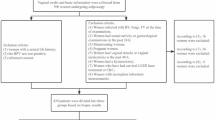Abstract
Chlamydia trachomatis serovars of 80 cervical samples from 70 pregnant and nonpregnant Japanese women were typed by the nested polymerase chain reaction and restriction fragment length polymorphism method. The correlation between the subjective genital symptoms in 54 nonpregnant women and 3 serogroups, B/ D/E, F/G/K, and H/I/J was investigated. The most common serovars were D (29%), E (21%), and G (19%). The proportions of serovars B, F, H, I, J, and K were 7% to 4%. Compared with other results from other countries, our study found serovar D and G seemed to be higher, and serovar F, lower, in Japanese women. Abdominal pain was noted in 45% (14/31) of nonpregnant women with serovar B/D/E, 31% (5/16) with F/ G/K, and 0% (0/7) with H/I/J. These results suggested that serovars B/D/E may cause stronger (P<0.05) symptoms than serovars H/I/J.
Similar content being viewed by others
References
Kuo CC, Wang SP, Holes KK, Grayston JT. Immunotypes ofChlamydia trachomatis isolates in Seattle. Infec Immunol 1983;41:865–868.
Ito JI, Lyons JM, Airo-Brown LP. Variation in virulence among oculogenital serovars ofChlamydia trachomatis in experimental genital tract infection. Infect Immunol 1990;58:2021–2023.
Batteiger B.E., Lennington W, Newhall WJV, Katz BP, Morrison HT, Jones RB. Correlation of infecting serovar and local inflammation in genitalChlamydia infection. J Infect Dis 1989;160:332–336.
Persson K, Osser S. Lack of evidence of a relationship between genital symptoms, cervicitis and salpingitis and different serovars ofChlamydia trachomatis. Eur J Clin Microbiol Infect Dis 1993;12:195–199.
Frost EH, Deslandes S, Veilleux S, B-Ramoisy D. TypingChlamydia trachomatis by detection of restriction fragment length polymorphism in the gene encoding the major outer membrane protein. J Infect Dis 1991;163:1103–1107.
Poole E, Lamont I.Chlamydia trachomatis serovar differentiation by direct sequence analysis of the variable segment 4 region of the major outer membrane protein gene. Infect Immun 1992;60:1089–1094.
Rodriguez P, Vekris A, Barbeyrac B, Dutilh B, Bonnet J, Bebear C. Typing ofChlamydia trachomatis by restriction endonuclease analysis of the amplified major outer membrane protein gene. J Clin Microbiol 1991;29:1132–1136.
Rodriguez P, Barbeyrac B, Persson K, Dutilh B, Bebear C. Evaluation of molecular typing for epidemiological study ofChlamydia trachomatis genital infections. J Clin Microbiol 1993;31:2238–2240.
Pugh SF, Slak RCB, Caul EO, Paul ID, Appleton PN, Gatley S. Enzyme amplified immunoassay: a novel technique applied to direction ofChlamydia trachomatis in clinical specimens. J Clin Pathol 1985;38:1139–1141.
Yoshida H, Kishi Y, Shiga S, Inouye S, Hagiwara T. Serotyping ofChlamydia trachomatis by polymerase chain reaction. Japan Arch Sex Trans Dis 1995;6:40–45.
Wang SP, Grayston JT. Three new serovars ofChlamydia trachomatis: Da, Ia, and L2a. J Infect Dis 1991;163:403–405.
Hagiwara T, Shiga S, Kojima T, Miyano A, Yamazaki S. distribution of serovars ofChlamydia trachomatis isolates in Japan. J Japan Assoc Inf Dis 1991;65:447–450.
Wagenvoort JHT, Suchland RJ, Stamma WE. Serovar distribution of urogenitalChlamydia trachomatis stains in The Netherlands. Genitourin Med 1988;64:159–161.
Barnes RC, Rompalo AM, Stamm WE. Comparison ofChlamydia trachomatis serovars causing rectal and cervical infections. J Infect Dis 1987;156:953–958.
Workowski KA, Stevens CE, Suchland RJ, Homes KK, Eschenbach DA, Pettinger MB, et al. Clinical manifestation of genital infection due toChlamydia trachomatis in women: differences related to serovar. Clin Infect Dis 1994;19:756–760.
Wang SP, Kuo CC, Barnes RC, Stephens RS, Grayston JT. Immunotyping ofChlamydia trachomatis with monoclonal antibodies. J Infect Dis 1985;152:791–800.
Ossewaarde JM, Rieffe M, De Vries A, Derksen-Nawrocki RP, Hooft HJ, Van Doornum GJJ, et al. comparison of two panels of monoclonal antibodies for determination ofChlamydia trachomatis serovars. J Clin Microbiol 1994;32:2968–2974.
Author information
Authors and Affiliations
About this article
Cite this article
Takahashi, K., Yoshida, H., Hagiwara, T. et al. Serovar distributions of genitalChalamydia trachomatis in Japanese women, and its correlation with clinical symptoms. J Infect Chemother 4, 32–35 (1998). https://doi.org/10.1007/BF02490064
Received:
Revised:
Accepted:
Issue Date:
DOI: https://doi.org/10.1007/BF02490064




